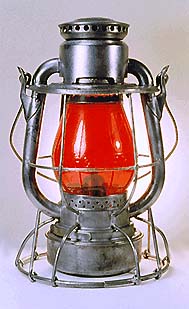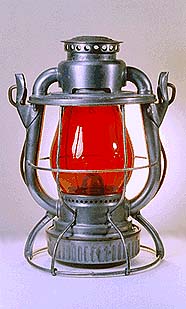|
|
Dietz "Vesta" Lanterns
 |
| Above: A "hi-top" Dietz Vesta marked "P.& L.E.
R.R." for the Pittsburgh & Lake Erie Railroad with a red
cast globe, last patent date of 12/13/10. |
 |
| Above: A "lo-top" Dietz Vesta marked "P.& L.E.
R.R." for the Pittsburgh & Lake Erie Railroad with a red
cast globe, production date of S-2-51. |
The "Vesta" was a popular line of brakeman's lantern manufactured
by the R.E. Dietz Company over a period of many decades. When collectors
refer to the "Dietz Vesta" they are usually thinking of the
last version of this model, the "lo-top" model or #6, which
is usually classified as a "short globe" lantern. However,
the name "Vesta" was applied by Dietz to a long series of lanterns,
and the original version, introduced in 1896, was actually a "tall
globe" lantern that took a 5 3/8" globe. By 1907, the version
that collectors know as the wire-bottom "hi-top" Vesta was
introduced, and this took a smaller 4 1/4" globe. At approximately
11" in height, the "hi-top" was as tall as most tall globe
lanterns but it had a smaller burning chamber to accommodate the weaker
flame of the fuel then coming into favor -- kerosene. After World War
One, Dietz redesigned the Vesta to make it smaller and more competitive
with newly-introduced short-globe lanterns, and this shorter "lo-top" version
is the one that is most familiar to collectors. In addition to these
major design changes, there were also less significant variations like
the use of bell-bottoms in the early models, the use of brass retaining
clips or wires to hold the fount in place, and differences in number
and placement of draft holes.
The one common feature of all Vesta models was the ventilation design
-- the so called "cold blast" design whereby air was circulated
through flanking tubes to produce a stronger flame. This design not only
gave Vesta lanterns a unique profile, but it was so functionally effective
that it was used for decades until Dietz discontinued Vesta production
around 1960. Because of this long production run, Dietz Vesta's are quite
common and therefore easily acquired by collectors. In fact, Vesta's
marked for the New York Central Railroad are probably the most frequently
seen railroad lantern in the antique market. However, while this makes
the Vesta less valuable as a collectible, it shouldn't obscure the fact
that the Vesta was a particularly good design that became common because
it was so successful. Generations of railroaders relied on them, and
no other "name brand" of railroad lantern lasted for so long.
A few other points to make about the Vesta:
- Until the mid-1950's or so, Dietz stamped patent dates on the lids
of their Vesta's, and at some point in the production of "lo-top" models,
the company stamped production dates on the lids as well.
- Many railroads bought Vesta's, but the vast majority of these lines
were located East of the Mississippi, particularly in the Northeast.
Vesta's seemed to be a special favorite of coal-hauling roads.
- While the "hi-top" and "lo-top" models were distinctly
different in height (see pictures above), they both took the same sized
globe, one that was 4 1/4" high. This was probably a special marketing
point with thrifty railroads who could switch to the smaller model
without requiring a new inventory of globes. Note the differences in
the frame, the size and construction of the founts, and the draft holes
below the globe
- Vestas made before 1956 have a number of dates stamped on the lid.
Dates with two numbers separated by a dash stand for month and year, i.e., "1-33" refers to January of 1933. The latest date is usually preceded by a "S" or "M".
The "S" means that the lantern was made on that date in Syracuse
at Plant 2. If the date had an "M" in front of it, that would
mean Main for Main plant in New York. Plant 1 went out of production
in 1931, and there were no more patent or production dates stamped
after 1956, when Dietz started production in Hong Kong. They started
stamping production and patent dates in 1915, although patent dates
alone can be found on earlier "Hi-Top" models.
- NEW Why the Vesta Name? The following was kindly provided by R.J. McCown: Historically, Barrett's 'Encyclopedia' shows the 'Vesta' name in use to designate an Archer, Pancoast & Co. lantern model at least as early as 1867. About that time Dietz bought out Archer and no doubt acquired the rights to the name along with all the other assets of the company. The name has survived through many corporate iterations and through several generations of lantern technologies, but it carries no significance to most people today. Why lanterns named 'Vesta? To quote from the Wikipedia article "Vesta (Mythology)": "Vesta (was) the virgin goddess of the hearth, home, and family in Roman religion. Vesta's presence (was) symbolized by the "Sacred fire of Vesta" that burned at her hearth and temples…." "…the temple of Vesta was the only ancient temple in Rome to be built in a round shape and covered with a dome to protect the sacred fire from rain, other temples being quadrangular." So all the hundreds of thousands of subsequent 'Vesta' lanterns, with their protected fires burning in their round 'temples' are really unknowing tributes to a Roman goddess! As a side note, Steam Gauge and Lantern (SGL&L) also offered a Vesta model. Archer sold out to Dietz, but before Dietz bought out SGL&L.
- See "Vesta
Valhalla" by Carl Ellerman (PDF Document) for more pictures
of different Vest variations.
- See pictures below of a rare,
threaded burner and fount from a Dietz Vesta "hi-top"
lantern with a last patent date of 4-09. The threaded burner (as
opposed to a twist-lock style burner) seems to have been made for
only a short period of time. Click on any image for a larger version.
Photos courtesy of Ray Turley and Jack Wall.
- See a variation of a low-top Vesta, perhaps a non-cataloged prototype,
with no air holes at the base of the globe on the frame, clips holding
the frame togeather instead of being soldered, legs under
the tubes being flat instead of having a ridge on them, and a wire
bail lock to keep
the bail in a upright position. The last patent date is S-1-25.
Click for photo 1, photo
2,
photo 3. Photos
courtesy of Ray Turley.
Notes :Information sources are Barrett; "Vesta
Valhalla" by Carl Ellerman, Key, Lock and Lantern, Volume
20, Number 4, Issue #84, Summer, 1987, pp 1588-1591, and "The Final
15%" by Jerry Fox, Key, Lock and Lantern, Volume 26, Number
2, Issue #106, Winter, 1994-95, pp 2231-2235. Thanks to Ken McCown and R.J. McCown
for comments and Ray Turley for photos.
|